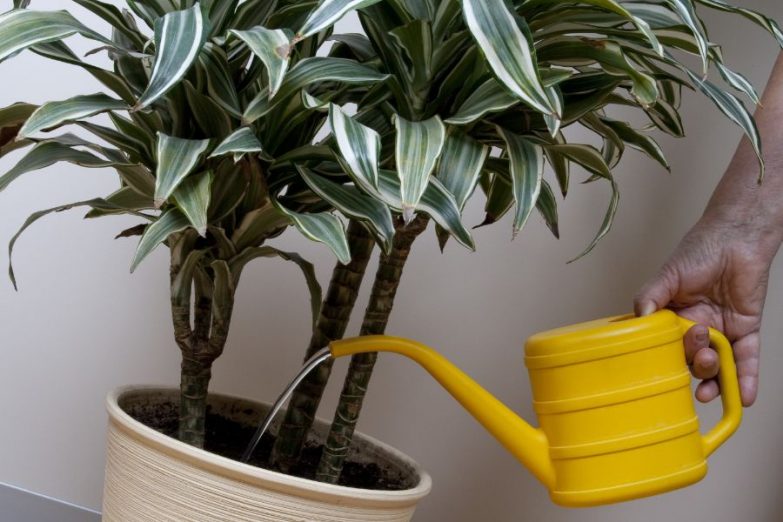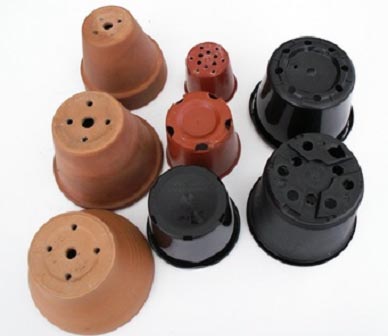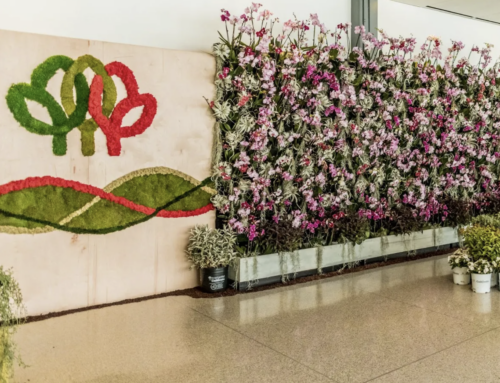Improper Watering: Under-rated and a Likely Cause for Plant Decline
In a recent posting, we discussed the importance of selecting soil mix for containers. Much of that topic directly influences how water moves through the soil to be available to the plant. This time we look into the significance of watering a containerized plant. Proper watering is vital to the plant’s health and especially if it is restricted to the confines of a container.
Two of the most common questions are: How do I know when my plant needs water? And, how often should I schedule watering my plants? The answer is not what people want to hear: Only water when it is needed. And Watering on a set time schedule is NOT the best method.

If you wonder how hard it can be to simply add water to the plant in the pot – the act is easy, but what happens to the water once it hits the soil and where it goes, is a concern. A good place to start is a reference back to the importance of the proper soil mix. Ideally, when water is added it should move downward in an even distribution pattern. This is most likely to occur when the container mix is soil-less or predominantly a soilless mix. These “engineered” mixes are designed to allow water to move throughout the soil in the container and leach through the bottom holes. Soilless mixes will dry out faster and require more frequent monitoring.
Unfortunately, many common “potting soils” hold too much water and the distribution of water to the roots may fail. Though it appears you are dutifully watering, the plant may look stressed because the water could be concentrating in a pocket area and only benefiting some of the roots. Unless the container is quite large, tall, or a unique design – it is best to water until it comes out the bottom. A good container soil mix allows this to happen.
With some potting soils, water may not come out the bottom, even after a considerable volume is added. If that happens, it might be best to change the soil. An exception may occur with low-quality potting soil, so don’t be fooled. Water moved by gravity takes the path of least resistance and when it cannot move adequately downward, it channels to the sides of the container. Once it reaches the container walls, there is little resistance and the water runs out the bottom without effectively covering the root system. It may appear that the plant has been successfully watered, but the water most likely by-passed much of the contained soil.
A similar situation occurs with soilless mixtures that have significantly dried out. The soil mix can shrink and pull away from the container sides. Re-wetting may be difficult as the soil mix might repel the water. Instead of sinking into the root zone area, water does not percolate down but sheds off to gaps created on the inside of the container and out the bottom – an ineffective effort. Repeated tries to re-wet this material are needed. Best results come from sinking the whole container in a tub or bucket and allowing that material to reabsorb water. When water appears at the top surface of the soil, the container may be pulled out.
What is the importance of water flowing out the bottom of the container?
- When it doesn’t come out the bottom, water could be saturating the soil (not always evident on the surface). Wet soil is conducive to many diseases and some insect problems.
- When the proper soil mix is used, it is one of the better indications water has distributed to most of the plant’s root system.
- Unless it is rainwater, distilled, or reverse osmosis (RO) water, most water will have naturally occurring soluble salts. Some are needed as minerals (fertilizer) but these and others can build up in the soil and become toxic. By watering until it flows out the bottom, the soluble salts are effectively pulled down through the soil and out.
- Municipal or city water and water treated by softener systems may have fluoride, chlorine, and other salts that need flushing out so they don’t reside in the soil.
- Failure to drain out the concentration of chemicals may impair the natural activity of beneficial soil microorganisms.
- Clay, ceramic, and cement containers that are kept outdoors year-round are subject to freezing. Soil mixes that hold water (without properly draining) are likely to freeze, expand, and crack the container.

Exceptions?
For large containers with a considerable amount of soil, it may not be practical “to water until it flows from the bottom” every time. Realistically it may take several watering occasions to achieve this leaching effect as the build-up of water finally releases.
What’s wrong with simply adding a small amount of water on a routine basis to keep the soil moist for the plant?
- Adding small amounts of water frequently does not move water downward and can cause shallow rooting. Applying a large volume of water on an infrequent basis promotes a deeper-rooted, healthier plant.
- Soil kept consistently moist is prone to disease and soil gnats. It is advised to allow the top 1-2 inches to periodically dry out.
- Watering in small amounts frequently causes a buildup of soluble salts and chemical concentrations (usually detrimental) to the soil.
What are some signs of residual salts and chemicals in the container soil?
- Watch for a whitish film or crust on the sides of containers (especially clay pots) and the soil surface.
- Plant health may be in decline: browned leaf edges or tips, leaf yellowing, wilting and reduced growth.
Is this problem correctable?
- Re-pot with an improved soil-less mixture and make sure there are plenty of holes in the container bottom.
- If an overhaul change of the soil is not an option, then consider a good flush. A good option is to water the plant outside (to a deck, patio, driveway, etc.) where you can see water come out the bottom. Add at least two times as much water as the volume of the container and witness it flowing out. I often recommend flooding the container, but that depends on the rate it percolates down. Be patient so the water doesn’t overflow. Considering the water quality you have, flushing may need to be done every several months. It is a good idea to do this at least once a year whether you see evidence of chemical build-up or not.
Does putting gravel in the container bottom improve drainage?
No, this Is a myth that has perpetuated for a long, long time. It sounds logical but defies the principles of agronomy. There are good scientific explanations for this but considering lack of time, space and to avoid getting too technical, search online for further details. The best drainage occurs with a consistent uniform soil mix from the top to the bottom hole.

What if the water coming from the bottom creates a mess on your tile floor, deck, or patio?
- Saucer dishes that fit beneath containers effectively catch the excess water. Do not allow the plants to sit in this drained water as it is often highly concentrated with soluble salts and chemicals. Water can be reabsorbed and wicked back up into container soil and the problem continues.
- Double Potting What if the container is decorative and beautiful but without bottom holes? Use a slightly smaller pot (with holes!) to drop inside. The water can move down and out through the interior pot and reside in the pot without holes. Use an object to elevate it so it isn’t sitting in the drained water.
As for the earlier question: How often do I water my plant?
Water only when it needs it. Seriously. A simple test is to sink your finger down 1 -2 inches into the soil surface. When it is dry and you do not feel moisture – it is time to water. It is difficult to put that on a schedule because the factors (temperature, sunlight, seasons, humidity, soil type, plant species, etc.) that influence a water routine often fluctuate. Overwater or watering when it is not needed often causes root rot problems. Oddly, plants suffering from too much water show symptoms of wilting, leaf discoloration, etc. – nearly the same symptoms of lack of water! Ignorant of this problem, the uninformed adds even more water hoping to rescue the withering plant making the situation even worse.
Hopefully, it is evident that the health of your containerized plant depends on following some of the basic principles of botany and agronomy. Over the years, the improvements in containers and soil mixes greatly reflect a better understanding of meeting the needs of a plant in a confined space. We’ve come a long way from the days of potting a geranium in soil from the backyard and placing it on the window sill.
-Rob McCartney, Horticulturist
Please feel free to contact me with any questions or for more info at: [email protected]




